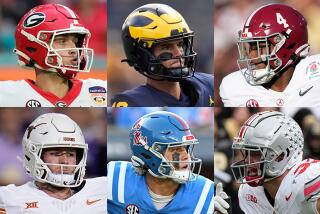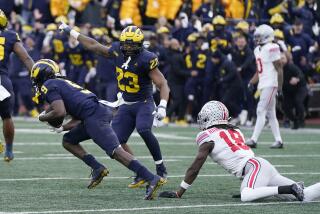From Big Least to Big Beast
- Share via
So the Big East got jilted by Miami, Virginia Tech and Boston College.
Turns out, it’s getting along very well without them.
While Atlantic Coast Conference Commissioner John Swofford wrestled with the aftermath of the Miami brawl this week, Big East Commissioner Mike Tranghese could sit back and peruse the polls.
West Virginia is No. 4.
Louisville is No. 6.
Rutgers -- Rutgers? -- is No. 19.
And Pittsburgh is lurking just outside the top 25.
Two years after the exodus from the Big East to the ACC began, three of the top 16 teams in the first Bowl Championship Series standings are from the Big East.
Only the Southeastern Conference has more, with four.
“Someone put something on my desk this morning -- these polls, I don’t even know which one -- and you see Rutgers ahead of Oklahoma,” said Pittsburgh Coach Dave Wannstedt, whose 6-1 team plays undefeated Rutgers today.
“To me, that kind of says it all.”
A lot could change as the top teams in the eight-team conference start playing each other -- the big one is between unbeatens West Virginia and Louisville Nov. 2 -- but for now, the Big East is riding high.
The league’s nonconference record is 32-8, the best in Big East history. Against the marauding ACC, the Big East is 5-3, hoisted by Louisville’s 31-7 victory over Miami and the clairvoyance of scheduling woeful North Carolina, which has lost to Rutgers and South Florida.
It is all a far cry from the scene before last year’s Sugar Bowl, when the Big East had gone 0 for 3 in bowl games and West Virginia was about to face Georgia in a game that had been displaced from New Orleans to Atlanta by Hurricane Katrina.
The talk was about the Big East being the Big Least after losing three of its best football programs in two years -- and about whether the league even deserved a spot in the Bowl Championship Series, the power consortium Tranghese once led.
“It was like every day I came in and had to read we weren’t good or didn’t belong,” said Tranghese, who had grown weary of what he called “getting battered” by the pundits.
Before the Sugar Bowl kickoff, his outlook was dim.
“I knew how good Georgia was,” Tranghese said. “Playing the SEC champion, plus playing the game in Atlanta, there weren’t a lot of people giving West Virginia much of a chance.”
West Virginia jumped to a 28-0 lead in what amounted to a coming-out party for running back Steve Slaton and quarterback Pat White, then held on to win, 38-35, after Coach Rich Rodriguez boldly called for a fake punt on fourth-and-long in the waning minutes to hold onto the ball.
“I just started laughing when the game was over,” Tranghese said. “I just laughed, because I knew how it must be for all those people pounding on us, pounding on our coaches and pounding on our conference.”
Now the next two seasons no longer look to be a death march toward the possibility of being booted out of the BCS when the six members are reviewed in 2008.
Tranghese had been telling Big East schools there was no point in worrying about that possibility, even as he privately worked on plans in case it did. He’s not spending a lot of time on that project these days.
“I obviously feel a lot better about our chances than two years ago,” he said.
Two reasons the Big East is getting along as well as it is: The resurgence of old stalwarts West Virginia and Pitt -- which only last season started 1-4 in Wannstedt’s first year -- and the success of less traditional programs.
Louisville proved an excellent addition after the defections.
And what has happened at Rutgers -- undefeated and leading the nation in scoring defense -- is astonishing. The question will be whether the school’s financial commitment to football amid campus budget woes that led to hundreds of lost jobs and the elimination of six sports will be enough to keep Coach Greg Schiano from bolting to Miami if Larry Coker is fired.
Tranghese said he thought Schiano would stay. “Greg is really invested in the program. He’s a Jersey guy,” Tranghese said.
Community ties might be what the Big East pins its hopes on as it tries to keep its coaching talent.
Wannstedt, a former NFL coach, played at Pittsburgh, and Rodriguez is also coaching at his alma mater.
Bobby Petrino is not, but the oft-courted Louisville coach was given a $25.5-million extension last summer in hopes of keeping him 10 more years. Wannstedt said players win games, but coaching and facilities help.
“You’re looking at experienced coaches right across the board, guys who have won or have winners now,” he said. “And most of the programs in the Big East -- Louisville, West Virginia, Cincinnati, South Florida -- everybody is building new facilities or trying to improve their current situation.”
Tranghese views South Florida as a program with potential, a 34,000-undergraduate state school in a talent hotbed. Syracuse is a once-powerful program still trying to get back to better times.
But overall these are giddy days for the Big East, though it is, after all, only half a season.
“It’s still real early in the process,” Schiano said. “So far, teams are playing well. When we reorganized the league a couple of years ago, I think everybody sitting in the room believed these programs were on the rise. There’s belief, and reality. So far, it looks good. We’ll see where it is at the end of the year.”
*
More to Read
Go beyond the scoreboard
Get the latest on L.A.'s teams in the daily Sports Report newsletter.
You may occasionally receive promotional content from the Los Angeles Times.










